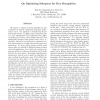Free Online Productivity Tools
i2Speak
i2Symbol
i2OCR
iTex2Img
iWeb2Print
iWeb2Shot
i2Type
iPdf2Split
iPdf2Merge
i2Bopomofo
i2Arabic
i2Style
i2Image
i2PDF
iLatex2Rtf
Sci2ools
ICCV
2009
IEEE
2009
IEEE
On optimizing subspaces for face recognition
We propose a subspace learning algorithm for face recognition by directly optimizing recognition performance scores. Our approach is motivated by the following observations: 1) Different face recognition tasks (i.e., face identification and verification) have different performance metrics, which implies that there exist distinguished subspaces that optimize these scores, respectively. Most prior work focused on optimizing various discriminative or locality criteria and neglect such distinctions. 2) As the gallery (target) and the probe (query) data are collected in different settings in many real-world applications, there could exist consistent appearance incoherences between the gallery and the probe data for the same subject. Knowledge regarding these incoherences could be used to guide the algorithm design, resulting in performance gain. Prior efforts have not focused on these facts. In this paper, we rigorously formulate performance scores for both the face identification and the ...
| Added | 18 Feb 2011 |
| Updated | 18 Feb 2011 |
| Type | Journal |
| Year | 2009 |
| Where | ICCV |
| Authors | Jilin Tu, Xiaoming Liu, Peter Henry Tu |
Comments (0)

